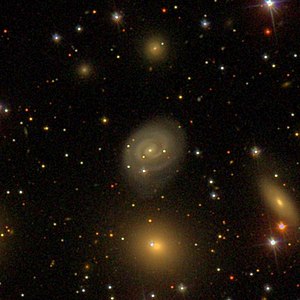NGC 1268
| Galaxy NGC 1268 |
|
|---|---|

|
|
| AladinLite | |
| Constellation | Perseus |
|
Position equinox : J2000.0 , epoch : J2000.0 |
|
| Right ascension | 03 h 18 m 45.1 s |
| declination | + 41 ° 29 ′ 19 ″ |
| Appearance | |
| Morphological type | SAB (rs) b: |
| Brightness (visual) | 13.8 mag |
| Brightness (B-band) | 14.6 mag |
| Angular expansion | 0.9 ′ × 0.6 ′ |
| Position angle | 120 ° |
| Surface brightness | 13 mag / arcmin² |
| Physical data | |
| Affiliation | Abell 426 |
| Redshift | 0.010884 ± 0.000133 |
| Radial velocity | 3263 ± 40 km / s |
|
Stroke distance v rad / H 0 |
(150 ± 11) · 10 6 ly (46.1 ± 3.3) Mpc |
| history | |
| discovery | Heinrich d'Arrest |
| Discovery date | February 14, 1863 |
| Catalog names | |
| NGC 1268 • UGC 2658 • PGC 12332 • CGCG 540-093 • MCG + 07-07-056 • 2MASX J03184515 + 4129191 • GALEX ASC J031845.29 + 412916.8 • LDCE 224 NED181 | |
NGC 1268 is a spiral galaxy of Hubble type Sb in the constellation Perseus in the northern sky . It is estimated to be 150 million light years from the Milky Way , about 40,000 ly in diameter, and a member of the Perseus Cluster Abell 426 . In the same area of the sky are u. a. the galaxies NGC 1267 , NGC 1270 , NGC 1271 , NGC 1272 .
The Type Ia supernova SN 2008fg was observed here.
The object was discovered by Heinrich d'Arrest on February 14, 1863 .
Web links
Commons : NGC 1268 - collection of images, videos, and audio files
